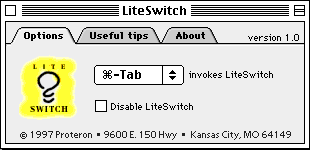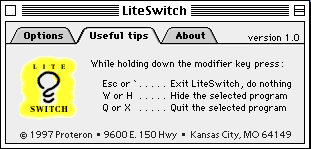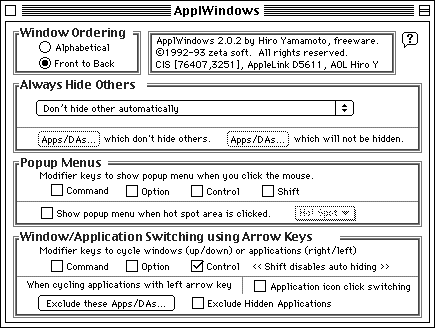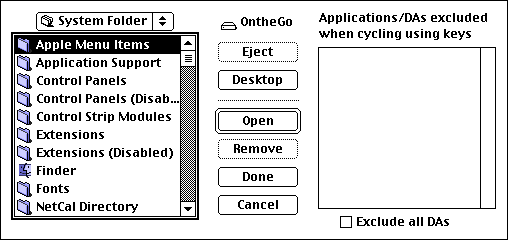- 2006.06.06
In recent weeks, I've been shifting more of my workflow to
several interesting applications available for the 680x0 Mac
platform. While an article featuring a detailed description of this
workflow is forthcoming, this is not the time for such stories.
Instead, the focus is on how to efficiently manage navigation
through multiple applications and their resulting clutter of
windows. While these tips focus on older Macs, the solutions are
not limited to that platform
Since I spend many hours a day on very small displays (14"
LC 580 or 9.5" PowerBook 520c), usually with a modest 640 x
480 screen resolution, I could very easily bog down from performing
excessive window manipulation hijinks. Each extra click to bring
forth a new application with a new set of windows to sort through,
which could stymie my best efforts to remain productive.
Later versions of the classic Mac OS include some measure of
quick application switching, but pre-8.5 versions didn't. And even
Mac OS 8.5-9.2.2 didn't have a feature complete solution.
Similarly, throughout multiple versions of the classic Mac OS,
many applications had their own shortcuts for cycling through open
windows.
Unfortunately, a feature for cycling through open windows was
not a systemwide component of the classic Mac OS. Even if every
application happens to have a shortcut for jumping between its
separate windows, each application tends to pick its own key
combination. Remembering all these keyboard shortcuts can be
confusing.
How many times has a user hit an arcane gesture to summon forth
the cycle command, only to be confused when the present application
doesn't respond to the beckoning? Even worse, how many times does
the command execute, only to respond with a completely different
action?
Yes, folks, sometimes different applications share the keyboard
shortcut - but for different behaviors.
Bottom line - maneuvering between applications and windows
shouldn't require excessive clicking, just a simple deft motion on
the keyboard. This concept doesn't have to limit itself to older
Macs with small displays and limited resolutions. Even on larger
monitors, getting from application one, window two, to application
two, window one, shouldn't be an Olympic event.
I suggest two control panels related in function, LiteSwitch and
ApplWindows, to accomplish these goals.
LiteSwitch
 First, let's take on
application switching with LiteSwitch. This free
control panel's sole duty is to enable application switching.
First, let's take on
application switching with LiteSwitch. This free
control panel's sole duty is to enable application switching.
When the selected modifier key (command, option, or control) is
pressed in conjunction with the tab key, a floating window appears.
The window remains present for as long as the key combination is
selected.
All currently running applications are listed horizontally in
this window. To cycle through, simply keep the modifier key
depressed while repeatedly press the tab key. To cycle in the
reverse direction, keep the shift key and modifier key depressed
while pressing the tab key.
 There are a few wrinkles
thrown in to complete the usefulness of this control panel. Hiding
and even quitting applications are but an extra modifier key away.
While a specific application is selected, press the "w" or "h" key
to hide or the "q" and "x" key to quit, and then tab over to the
next application to complete the desired action. These shortcuts
can be applied to every running application in one invocation of
LiteSwitch.
There are a few wrinkles
thrown in to complete the usefulness of this control panel. Hiding
and even quitting applications are but an extra modifier key away.
While a specific application is selected, press the "w" or "h" key
to hide or the "q" and "x" key to quit, and then tab over to the
next application to complete the desired action. These shortcuts
can be applied to every running application in one invocation of
LiteSwitch.
If you want to exit LiteSwitch without making modifications to
the running applications, press "esc" or "`".
 Visual
feedback is well thought out. The listed applications are
identified by both their icon, and, when an icon is selected, the
application name is listed on the bottom of the LiteSwitch window
(right). When an application is selected, a square outline envelops
the icon. When an application is hidden or quit, the icon grays out
for the former and an "X" marks through the icon in the latter
scenario.
Visual
feedback is well thought out. The listed applications are
identified by both their icon, and, when an icon is selected, the
application name is listed on the bottom of the LiteSwitch window
(right). When an application is selected, a square outline envelops
the icon. When an application is hidden or quit, the icon grays out
for the former and an "X" marks through the icon in the latter
scenario.
The LiteSwitch control panel is easy to configure, as there is
only one thing to configure - the modifier key for the tab switch
mechanism. A pulldown menu brings forth the command, option, or
control selection.
No system requirements listed, but it works on every 680x0 or
PPC Mac from System 7.5 to Mac OS 9.2.2 that I have used for
testing. It probably works back to System 7.1.
ApplWindows
ApplWindows is much
more powerful and configurable than LiteSwitch by any measure.
Having stated this, I only use ApplWindows to switch between
windows within an application.
At one time I used ApplWindows to handle all my switching needs,
but I prefer the more traditional tab method utilized by LiteSwitch
versus the more feature rich ApplWindows method.
ApplWindows allows a user to specify whether an application
automatically hides when switching to another application. Specific
behavior for hiding applications can be fine-tuned by setting
exemptions for certain applications and/or for the mechanism used
to bring the application forward.
A popup menu application switcher can be set to appear by
modifier key and mouse click and/or with a hot corner.

The actual switching of applications or windows is accomplished
by setting a modifier key (the ubiquitous command, option, and
control keys yet again) to accompany the arrow keys. The up or down
arrow keys switch between open windows in a given application, and
the left and right arrow keys switch between running
applications.
Further fine-tuning can be accomplished by excluding hidden
applications or setting a list of applications which will not be
switched.

System requirements: Mac OS 7.1 - 9.2.2.
Conclusion
Having detailed the workings of ApplWindows, I will reemphasize
this point: I prefer LiteSwitch for application switching and
ApplWindows for switching between windows.
ApplWindows doesn't give me a way to hide, quit, and switch
through my running programs in one invocation. Additionally, I
cannot switch between running applications in the same visual
manner as LiteSwitch's temporary floating window.
If a dedicated user were to take the time and configure
appropriate exemptions to automatically hide and switch
applications, ApplWindows could be the superior tool for the job.
Luckily, both applications can run concurrently, and neither
demands much in the way of system resources. I would suggest using
the pair together to best take advantage of each control panels'
strong points.
The next part of this series will continue to look at more ways
to work around or correct possible bottlenecks in your workflow.

 First, let's take on
application switching with
First, let's take on
application switching with  There are a few wrinkles
thrown in to complete the usefulness of this control panel. Hiding
and even quitting applications are but an extra modifier key away.
While a specific application is selected, press the "w" or "h" key
to hide or the "q" and "x" key to quit, and then tab over to the
next application to complete the desired action. These shortcuts
can be applied to every running application in one invocation of
LiteSwitch.
There are a few wrinkles
thrown in to complete the usefulness of this control panel. Hiding
and even quitting applications are but an extra modifier key away.
While a specific application is selected, press the "w" or "h" key
to hide or the "q" and "x" key to quit, and then tab over to the
next application to complete the desired action. These shortcuts
can be applied to every running application in one invocation of
LiteSwitch. Visual
feedback is well thought out. The listed applications are
identified by both their icon, and, when an icon is selected, the
application name is listed on the bottom of the LiteSwitch window
(right). When an application is selected, a square outline envelops
the icon. When an application is hidden or quit, the icon grays out
for the former and an "X" marks through the icon in the latter
scenario.
Visual
feedback is well thought out. The listed applications are
identified by both their icon, and, when an icon is selected, the
application name is listed on the bottom of the LiteSwitch window
(right). When an application is selected, a square outline envelops
the icon. When an application is hidden or quit, the icon grays out
for the former and an "X" marks through the icon in the latter
scenario.


